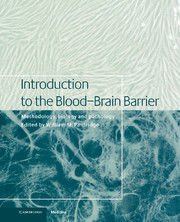Book contents
- Frontmatter
- Contents
- List of contributors
- 1 Blood–brain barrier methodology and biology
- Part I Methodology
- 2 The carotid artery single injection technique
- 3 Development of Brain Efflux Index (BEI) method and its application to the blood–brain barrier efflux transport study
- 4 In situ brain perfusion
- 5 Intravenous injection/pharmacokinetics
- 6 Isolated brain capillaries: an in vitro model of blood–brain barrier research
- 7 Isolation and behavior of plasma membrane vesicles made from cerebral capillary endothelial cells
- 8 Patch clamp techniques with isolated brain microvessel membranes
- 9 Tissue culture of brain endothelial cells – induction of blood–brain barrier properties by brain factors
- 10 Brain microvessel endothelial cell culture systems
- 11 Intracerebral microdialysis
- 12 Blood–brain barrier permeability measured with histochemistry
- 13 Measuring cerebral capillary permeability–surface area products by quantitative autoradiography
- 14 Measurement of blood–brain barrier in humans using indicator diffusion
- 15 Measurement of blood–brain permeability in humans with positron emission tomography
- 16 Magnetic resonance imaging of blood–brain barrier permeability
- 17 Molecular biology of brain capillaries
- Part II Transport biology
- Part III General aspects of CNS transport
- Part IV Signal transduction/biochemical aspects
- Part V Pathophysiology in disease states
- Index
6 - Isolated brain capillaries: an in vitro model of blood–brain barrier research
from Part I - Methodology
Published online by Cambridge University Press: 10 December 2009
- Frontmatter
- Contents
- List of contributors
- 1 Blood–brain barrier methodology and biology
- Part I Methodology
- 2 The carotid artery single injection technique
- 3 Development of Brain Efflux Index (BEI) method and its application to the blood–brain barrier efflux transport study
- 4 In situ brain perfusion
- 5 Intravenous injection/pharmacokinetics
- 6 Isolated brain capillaries: an in vitro model of blood–brain barrier research
- 7 Isolation and behavior of plasma membrane vesicles made from cerebral capillary endothelial cells
- 8 Patch clamp techniques with isolated brain microvessel membranes
- 9 Tissue culture of brain endothelial cells – induction of blood–brain barrier properties by brain factors
- 10 Brain microvessel endothelial cell culture systems
- 11 Intracerebral microdialysis
- 12 Blood–brain barrier permeability measured with histochemistry
- 13 Measuring cerebral capillary permeability–surface area products by quantitative autoradiography
- 14 Measurement of blood–brain barrier in humans using indicator diffusion
- 15 Measurement of blood–brain permeability in humans with positron emission tomography
- 16 Magnetic resonance imaging of blood–brain barrier permeability
- 17 Molecular biology of brain capillaries
- Part II Transport biology
- Part III General aspects of CNS transport
- Part IV Signal transduction/biochemical aspects
- Part V Pathophysiology in disease states
- Index
Summary
Introduction
The development of techniques for isolation of capillaries from either laboratory animal brain or human autopsy brain was an important event in the evolution of blood–brain barrier (BBB) methodologies. It was the availability of isolated capillaries that allowed BBB research to evolve from organ physiology to the cellular and molecular level. Bovine and human brain capillaries were initially isolated by Siakatos et al. (1969) and by several groups in the early and mid-1970s (Joo and Karnushina, 1973; Brendel et al., 1974; Goldstein et al., 1975). These methodologies uniformly used mechanical homogenization techniques and subsequent studies showed that capillaries isolated with mechanical homogenization methods did not exclude Trypan Blue and were metabolically leaky (Williams et al., 1980). Although microvessels isolated with an enzymatic homogenization technique and which are not mechanically disturbed do generally exclude Trypan Blue, these microvessels are also metabolically impaired. The adenosine triphosphate (ATP) concentration in capillaries isolated from brain with either a mechanical or an enzymatic homogenization technique is decreased more than 90% (Lasbennes and Gayet, 1984). The serious depletion of ATP in brain microvessels isolated with an enzymatic homogenization technique is a puzzling phenomenon since, in general, cells that are isolated with an enzymatic homogenization technique have normal ATP supplies (Kilberg, 1982).
- Type
- Chapter
- Information
- Introduction to the Blood-Brain BarrierMethodology, Biology and Pathology, pp. 49 - 61Publisher: Cambridge University PressPrint publication year: 1998
- 12
- Cited by



